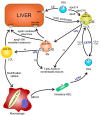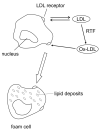The Influence of Polyphenols on Atherosclerosis Development
- PMID: 37108307
- PMCID: PMC10139042
- DOI: 10.3390/ijms24087146
The Influence of Polyphenols on Atherosclerosis Development
Abstract
Polyphenols have attracted tremendous attention due to their pro-health properties, including their antioxidant, anti-inflammatory, antibacterial and neuroprotective activities. Atherosclerosis is a vascular disorder underlying several CVDs. One of the main risk factors causing atherosclerosis is the type and quality of food consumed. Therefore, polyphenols represent promising agents in the prevention and treatment of atherosclerosis, as demonstrated by in vitro, animal, preclinical and clinical studies. However, most polyphenols cannot be absorbed directly by the small intestine. Gut microbiota play a crucial role in converting dietary polyphenols into absorbable bioactive substances. An increasing understanding of the field has confirmed that specific GM taxa strains mediate the gut microbiota-atherosclerosis axis. The present study explores the anti-atherosclerotic properties and associated underlying mechanisms of polyphenols. Moreover, it provides a basis for better understanding the relationship between dietary polyphenols, gut microbiota, and cardiovascular benefits.
Keywords: atherosclerosis; cardiovascular diseases; gut microbiota; inflammatory diseases; oxidative stress; polyphenols.
Conflict of interest statement
The authors declare no conflict of interest.
Figures





Similar articles
-
Gut Microbiota Modulation and Anti-Inflammatory Properties of Dietary Polyphenols in IBD: New and Consolidated Perspectives.Curr Pharm Des. 2017;23(16):2344-2351. doi: 10.2174/1381612823666170207145420. Curr Pharm Des. 2017. PMID: 28176667 Review.
-
Polyphenolic Compounds and Gut Microbiome in Cardiovascular Diseases.Curr Pharm Biotechnol. 2020;21(7):578-586. doi: 10.2174/1389201020666191111150239. Curr Pharm Biotechnol. 2020. PMID: 31713494 Review.
-
Role of gut microbiota in the immunopathology of atherosclerosis: Focus on immune cells.Scand J Immunol. 2022 Jul;96(1):e13174. doi: 10.1111/sji.13174. Epub 2022 May 2. Scand J Immunol. 2022. PMID: 35474231 Review.
-
Millet shell polyphenols prevent atherosclerosis by protecting the gut barrier and remodeling the gut microbiota in ApoE-/- mice.Food Funct. 2021 Aug 21;12(16):7298-7309. doi: 10.1039/d1fo00991e. Epub 2021 Jun 25. Food Funct. 2021. PMID: 34169953
-
Dietary Polyphenol, Gut Microbiota, and Health Benefits.Antioxidants (Basel). 2022 Jun 20;11(6):1212. doi: 10.3390/antiox11061212. Antioxidants (Basel). 2022. PMID: 35740109 Free PMC article. Review.
Cited by
-
Does Resveratrol Improve Metabolic Dysfunction-Associated Steatotic Liver Disease (MASLD)?Int J Mol Sci. 2024 Mar 27;25(7):3746. doi: 10.3390/ijms25073746. Int J Mol Sci. 2024. PMID: 38612556 Free PMC article. Review.
-
From Waste to Wealth: Exploring the Bioactive Potential of Wine By-Products-A Review.Antioxidants (Basel). 2024 Aug 15;13(8):992. doi: 10.3390/antiox13080992. Antioxidants (Basel). 2024. PMID: 39199237 Free PMC article. Review.
-
Impact of thermal processing on polyphenols, carotenoids, glucosinolates, and ascorbic acid in fruit and vegetables and their cardiovascular benefits.Compr Rev Food Sci Food Saf. 2024 Nov;23(6):e13426. doi: 10.1111/1541-4337.13426. Epub 2024 Aug 21. Compr Rev Food Sci Food Saf. 2024. PMID: 39169551 Free PMC article. Review.
-
Free Radical-Mediated Grafting of Natural Polysaccharides Such as Chitosan, Starch, Inulin, and Pectin with Some Polyphenols: Synthesis, Structural Characterization, Bioactivities, and Applications-A Review.Foods. 2023 Oct 8;12(19):3688. doi: 10.3390/foods12193688. Foods. 2023. PMID: 37835341 Free PMC article. Review.
-
Visualization of Atherosclerotic Plaques Paired with Joheksol 350 (Omnipaque).Biomedicines. 2025 Feb 7;13(2):399. doi: 10.3390/biomedicines13020399. Biomedicines. 2025. PMID: 40002812 Free PMC article.
References
-
- Carluccio M.A., Massaro M., Scoditti E., Caterina R. Atherosclerosis and Mediterranean Diet Polyphenols. Polyphen. Hum. Health Dis. 2013;2:895–903. doi: 10.1016/B978-0-12-398456-2.00069-4. - DOI
Publication types
MeSH terms
Substances
LinkOut - more resources
Full Text Sources
Medical

